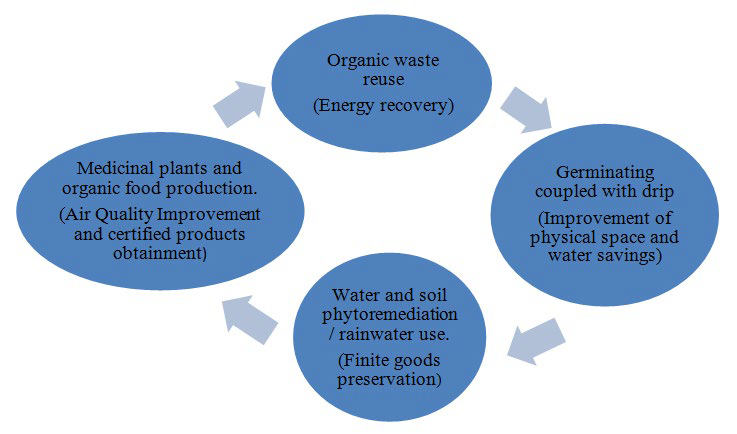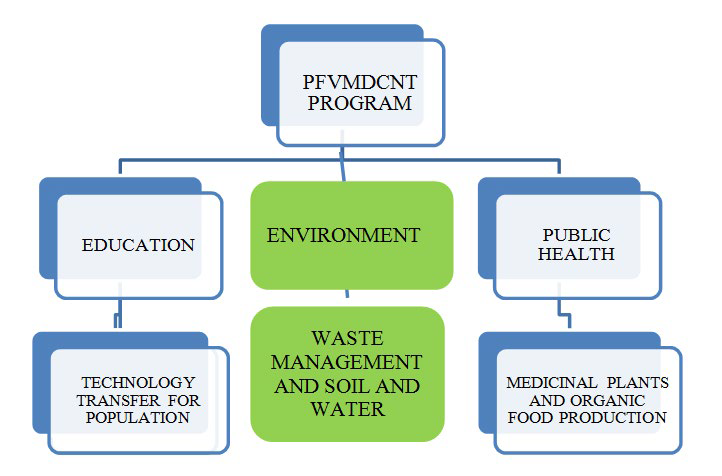INTRODUCTION
The Micropropagation live Pharmacy for Chronic Non-communicable Diseases (CND) Program (PFVMDCNT) emerged in 2015 at the Faculty of Pharmaceutical Sciences of University of São Paulo, Brazil as a new strategy for reorienting the agricultural production model in conventional living pharmacies. It is believed that the search for new models of obtaining food and medicinal plants derives from a socio-historical moment where the technicalities/mechanized model no longer meets the emergency of the modern world changes and hence to organic food needs and accessible medicinal plants to all social strata. The city of Fortaleza was one of the pioneers in the development of herbal medicine, actions in public health and served as a model, along with other experiences in the country, to the guidelines formulation for “medicinal plants and herbal medicine” in the National Integrative and Complementary Practices Policy.1,2 Currently, the great demographic concentration in cities responsible to the urban exodus, makes one search for new technologies to combine a healthy life with the coexistence amidst the pollution and reduced physical space of the big cities. Conventional living pharmacies require a huge physical space which leave is restricted only to people who have such spaces. This generates exclusion, making it impossible for everyone to have access to green and healthy environments. Such fact accentuates the disease process of human beings due to air pollution and poor diet. Then, the PFVMDCNT presents itself as a new way of sustainability and public health working, having the feasibility of the mini urban farms and urban orchards creation and popularization, through technology transfer to the population, thus having not only a urban garden matrix construction isolated within the university, but the idea of introducing a new vision in the health intervention process so that it is not expect the population to get ill and look for hospitals, once it acts preventively on it from a healthy diet model and use of medicinal plants, improved air quality, and visual beauty of nature. Based on these considerations, this study aims to reflect on PFVMDCNT potential in the process of model changing from conventional living pharmacies for the micropropagation model. To this end, we opted for reflective descriptive methodology, based on relevant literature on the subject, in order to contribute to a reflection of the transformations occurred in the conventional agricultural model and the emergence of new agriculture biotechnology techniques, particularly the PFVMDCNT, that utilizes the micropropagation as a planting technique, with space reduction, greater results reproducibility and greater amount of organic foods and medicinal plants.
MICROPROPAGATION
Asexual reproduction is used to obtain a large number of seedlings from a single plant. Depending on the case, bulbs (onions), corms (gladiolus), rhizomes (ferns), tubers (English potatoes), stems (banana), roots (sweet potato, apple, blackberry), leaves (begonia, sword-of-saint-jorge), cuttings (vines) etc. can be utilized.3 The plants obtained by vegetative or asexual propagation are identical to the parent plant and identical to each other. In other words, they are clones. It is called totipotency the cell ability to generate replicas of the organism from which it derives. Restricted in animals, this characteristic property allows plants to survive in unfavorable environmental conditions or after herbivores, pests and pathogens attack.3 The in vitro culture or micropropagation begins with the extraction of small tissue fragments removed from various parts of the plant, such as leaves, roots, nodes and the axillary buds, floral and apical buds. Once cleaned and disinfected, the explants are aseptically transferred to a suitable culture medium. Periodic subcultures of these explants permit material amplification, and later, their differentiation in order to generate whole plants.3 As the in vitro culture can be developed initially in reduced space and regardless of climatic factors and seasons, it is possible to produce satisfactory amounts of food and medicinal plants all year. It is estimated that 10 m2 shelves are sufficient for 20,000 seedlings growing (Malajovich, GUIA80). Therefore, the number of individuals produced by in vitro culture is much higher than the number of individuals that could be obtained by the traditional multiplying method. An eucalyptus gem cultivation can give 75 trillion seedlings a year instead of 100 or 200 which are normally obtained by cutting. These results are of great interest for the paper, pulp and wood industries.3 In vitro culture enables pathogen free plants from meristematic tissues production and distribution, which are not infected by viruses. An example is the virus-free potato tubers production for inclusion in potato-seed certification programs. It also allows the production of synthetic seeds, which consists of a embryoid formed from a mass of tissue obtained in vitro, wrapped in a nutrient gelatinous substance and covered by a biodegradable plastic.3 The set constitutes of an artificial seed which develops normally when planted in soil. Launched from aircraft, these seeds facilitate reforestation in difficult access degraded areas. Vegetables in vitro culture techniques were quickly assimilated by companies and research and development institutions, once they facilitate the commercial varieties genetic improvement and also they represent an indispensable step in obtaining a transgenic plant. Being techniques of public domain, relatively simple and inexpensive, many companies use them, worldwide, to ensure the genetic and phytosanitare quality of marketed seeds and seedlings. This technology is widespread in Latin America, where it is the second most traded commodity in agricultural biotechnology, with wide dissemination in oleiculture, in hortifruticulture, in floriculture and in ornamental plants propagation, as well as in industrial interest plants production (cane, coffee) and forest species seedlings for the paper industry.3
MICROPROPAGATION LIVE PHARMACY FOR CNDs PROGRAM
The study of new techniques to associate large cities development to sustainability is increasingly necessary. It must be take into account the respect for the environment and preservation of natural resources. The current issue is how to get quality organic food and medicinal plants having as limiting factors, the cities high degree of urbanization and reduced physical space. Inside the micropropagation living pharmacy for Chronic Non-communicable Diseases (CNDs) program are developed several research projects, each of which facing one CND affecting the population. All projects have in common the waste management, energy recovery through organic waste reuse, fruits and vegetables, and use of rainwater in drip irrigation system, and some projects also have the phytoremediation of soils and waters in its scope (Figure 1).
Figure 1: Production cycle

The difference of the living pharmacy production system for CND is the seeding technique called micropropagation, which takes place via direct organogenesis, this being the wider applicability of the tissue culture technique and is routinely used to multiply large quantities of selected genotypes uniform plants retaining the genetic fidelity.4 The in vitro plants stock allows a continuous flow of production at all seasons of the year, and allows the production of seedlings from organs already developed what is, in general, not achieved in natural field conditions. Thanks to this technique it is possible to obtain large amounts of medicinal plants, fruits and vegetables ensuring the medicinal plants and organic food origin certification. This technique can be applied to large-scale medicinal plants production for herbal medicines production to supply the Unified Health System (SUS) in the primary care for chronic diseases program. The SUS is public health system in Brazil. It ensures comprehensive, universal and equal access to the Brazilian population, from simple outpatient care to organ transplants. Regarding food production it will be possible to produce micro- and macroscale, both industries may employ the organic producing technique, as well as individuals or families, with maximum energy expenditure and physical space saving. The micropropagation success depends on the better understanding of the knowledge of the plant cells nutritional requirements specific for each plant species.4 Therefore, cultivate a living pharmacy by micropropagation ensures the obtained plants reproducibility and traceability, making it possible through micropropagation obtain organic food and medicinal plants larger amounts all year. Apart from intervene positively in the public health, PFVMDCNT contributes to the environment and environmental education, through organic waste management, and technology transfer to population (Figure 2)
Figure 2: Chart of PFVMDCNT program.

FINAL CONSIDERATIONS
The light of the review presented here it is possible to understand that the PFVMDCNT brings a new strategy for the Chronic Non-communicable Diseases prevention and treatment. Cultivate a living pharmacy by micropropagation ensures reproducibility and traceability of the plants obtained, making it possible to obtain larger amounts of organic food and medicinal plants all year, thus being most auspicious compared to the conventional model. In addition to intervene positively in the public health, PFVMDCNT contributes to the environment and environmental education, through organic waste management, and technology transfer to population.
CONFLICTS OF INTEREST
The authors delare that they have no conflicts of interest in relation to this article.







